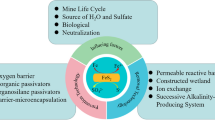Abstract
Since 1996, hydrogeochemical surveys have been carried out in the abandoned Montevecchio Pb-Zn mining district (Sardinia, Italy), where mine drainages discharge directly into the local streams, to investigate variations in the aqueous occurrence of contaminants. Natural attenuation in dissolved contaminants occurs downstream of the abandoned mines. Iron is removed first (about 2 km downstream); lead, aluminum, and copper follow (about 4 km downstream). Other metals, such as zinc, cadmium, nickel, and rare earth elements, decrease further downstream. At high flow, natural attenuation is mainly due to dilution by rainwater. At low flow, natural attenuation processes are dominated by solid phase precipitation, efflorescent salt formation due to evaporation, and dilution by uncontaminated surface and/or groundwater inflow. Overall, concentrations of sulphate, Zn, Cd, Pb, Cu, Ni, and Co were less in 2010 than in 1996. The concentrations of dissolved sulphate and metals are lowest when the water is less acidic. However, despite ongoing natural attenuation, very high concentrations of toxic metals continue to be observed 15 years after the underground workings flooded. The amount of contaminants reaching the Marceddì lagoon increases as runoff increases following heavy rains.









Similar content being viewed by others
References
Berger AC, Bethke CM, Krumhansl JL (2000) A process model of natural attenuation in drainage from a historic mining district. Appl Geochem 15:655–666
Biddau M (1978) Indagine chimica-idrologica sulle possibilità di utilizzazione delle acque edotte nel Sulcis-Iglesiente. La Programmazione in Sardegna 67(68):99–115 in Italian
Bigham JM, Schwertmann U, Traina SJ, Winland RL, Wolf M (1996) Schwertmannite and the chemical modeling of iron in acid sulphate waters. Geochim Cosmochim Acta 60(12):2111–2121
Caboi R, Cidu R, Fanfani L, Zuddas P (1996) Abandoned mine sites: implications for water quality. In: Ciccu R (ed) Proc, SWEMP 96, vol 2. DIGITA Univ of Cagliari, Italy, pp 797–805
Chapman BM, Jones DR, Jung RF (1983) Processes controlling metal ion attenuation in acid mine drainage stream. Geochim Cosmochim Acta 47:1957–1973
Cherry DS, Currie RJ, Soucek DJ, Latimer HA, Trent GC (2001) An integrative assessment of a watershed impacted by abandoned mined land discharges. Environ Poll 111:377–388
Da Pelo S (1998) Mineralogia e geochimica ambientale di aree minerarie attive e dismesse. PhD Thesis, Univ di Cagliari (in Italian), Cagliari, Italy
Da Pelo S, Corsini F, Lattanzi P, Parrini P Zuddas P (1996) Mineralogia e geochimica degli sterili di flottazione nell’area mineraria di Montevecchio, Sardegna: dati preliminari. In: Tanelli G (ed) Proc, Le proprietà dei minerali e le loro applicazioni alle problematiche ambientali, culturali e industriali, 1° incontro scientifico nazionale, vol 1. University of Modena, Italy, pp 33–35 (in Italian)
Dold B, Fontboté L (2001) Element cycling and secondary mineralogy in porphyry copper tailings as a function of climate, primary mineralogy and mineral processing. J Geochem Explor 74:3–55
Gandy CJ, Younger PL (2007) Predicting groundwater rebound in the South Yorkshire Coalfield, UK. Mine Water Environ 26:70–78
Hudson-Edwards KA, Macklin M, Curtis C, Vaughan D (1996) Processes of formation and distribution of Pb-, Zn-, Cd-, and Cu-bearing minerals in the Tyne Basin, northeast England: implications for metal-contaminated river systems. Environ Sci Technol 30:72–80
Kimball BA, Bianchi F, Walton-Day K, Runkel RL, Nannucci M, Salvadori A (2007) Quantification of changes in metal loading from storm runoff, Merse River (Tuscany, Italy). Mine Water Environ 26:209–216
Lim H-S, Lee J-S, Chon H-T, Sager M (2008) Heavy metal contamination and health risk assessment in the vicinity of the abandoned Songcheon Au–Ag mine in Korea. J Geochem Explor 96:223–230
McLennan SM (1989) Rare earth elements in sedimentary rocks: influence of provenance and sedimentary processes. In: Lipin BR, McKay GA (eds) Geochemistry and Mineralogy of Rare Earth Elements, Rev Mineral, vol 21. Mineralogical Society of America, Washington, DC, USA, pp 169–199
Navarro MC, Pérez-Sirvent C, Martínez-Sánchez MJ, Vidal J, Tovar PJ, Bech J (2008) Abandoned mine sites as a source of contamination by heavy metals: a case study in a semi-arid zone. J Geochem Exploration 96:183–193
Nordstrom DK (2009) Acid rock drainage and climate change. J Geochem Exploration 100:97–104
Nordstrom DK, Alpers CN (1999) Negative pH, efflorescent mineralogy, and consequences for environmental restoration at the Iron Mountain Superfund site, California. P Natl Acad Sci USA 96:3455–3462
Parkhurst DL, Appelo CAJ (1999) User’s guide to PHREEQC (version 2)—a computer program for speciation, batch-reaction, one-dimensional transport, and in-verse geochemical calculations. USGS Water-Resources Investigations Report 99-4259, Denver, CO, USA
Pérez-López R, Delgado J, Nieto JM, Márquez-García B (2010) Rare earth element geochemistry of sulphide weathering in the São Domingos mine area (Iberian Pyrite Belt): a proxy for fluid–rock interaction and ancient mining pollution. Chem Geol 276:29–40
Ren HY, Zhuang DF, Singh AN, Pan JJ, Qiu DS, Shi RH (2009) Estimation of As and Cu contamination in agricultural soils around a mining area by reflectance spectroscopy: a case study. Pedosphere 19:719–726
Stumm W, Morgan JJ (1996) Aquatic Chemistry. 3rd Edit, John Wiley & Sons, NY
Verplanck PL, Nordstrom DK, Howard E, Taylor HE, Kimball BA (2004) Rare earth element partitioning between hydrous ferric oxides and acid mine water during iron oxidation. Appl Geochem 19:1339–1354
Wolkersdorfer C, Bowell R (eds) (2005) Contemporary reviews of mine water studies in Europe. Mine Water Environ 24: Supplement
Yu JY, Heo B, Choi IK, Cho JP, Chang HW (1999) Apparent solubilities of schwertmannite and ferrihydrite in natural stream waters polluted by mine drainage. Geochim Cosmochim Acta 63:3407–3416
Acknowledgments
Authors thank the EU (Umbrella project, FP7 no. 226870), the University of Cagliari, and the Fondazione Banco di Sardegna for financial support. Thanks to Dr. D.C. “Bear” McPhail (Research School of Earth Sciences, Australian National University, Canberra, Australia) for providing the hemimorphite solubility constant.
Author information
Authors and Affiliations
Corresponding author
Rights and permissions
About this article
Cite this article
Cidu, R., Frau, F. & Da Pelo, S. Drainage at Abandoned Mine Sites: Natural Attenuation of Contaminants in Different Seasons. Mine Water Environ 30, 113–126 (2011). https://doi.org/10.1007/s10230-011-0146-4
Received:
Accepted:
Published:
Issue Date:
DOI: https://doi.org/10.1007/s10230-011-0146-4




